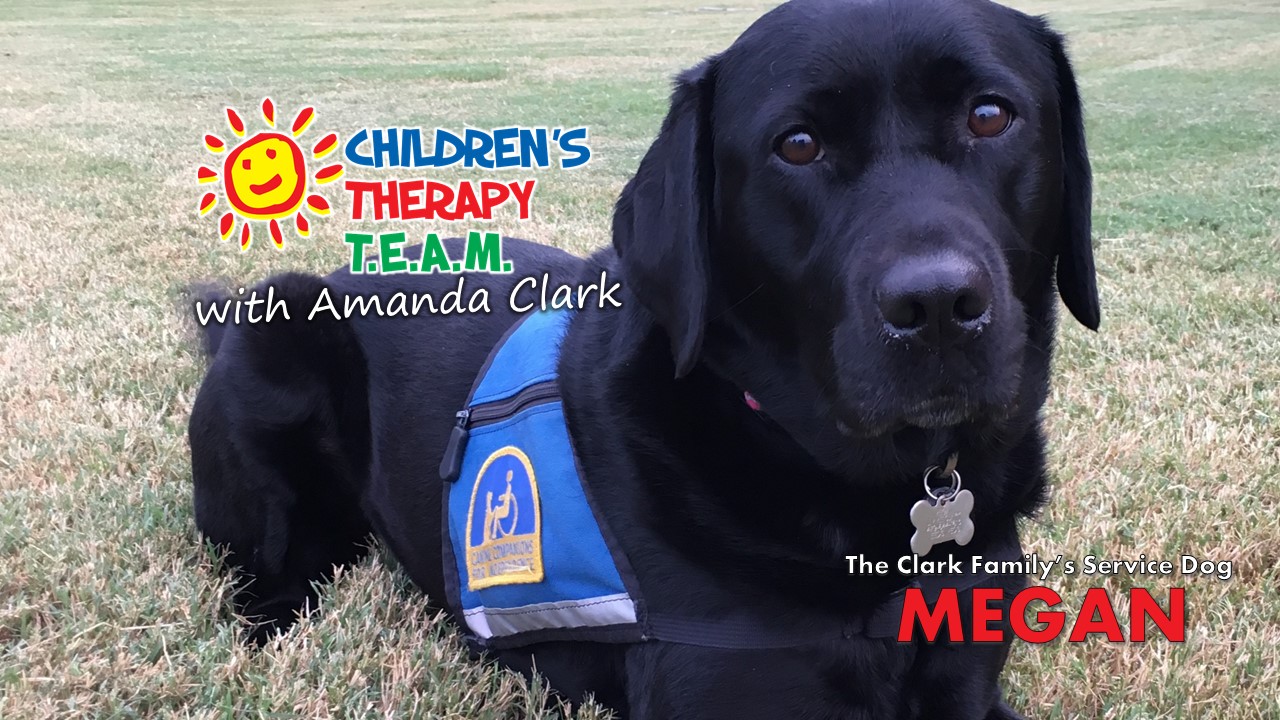 Last week we explored the question of what constitutes a “service animal” and discussed the differences between a service animal and a comfort companion. To recap:
Last week we explored the question of what constitutes a “service animal” and discussed the differences between a service animal and a comfort companion. To recap:- Service animal – provides a particular action/task for an individual with a disability and is protected by the Americans with Disabilities Act (ADA).
- Comfort companion – provides comfort & support (rather than a particular action) and is NOT covered by the ADA.
Did you know that we have not one but two highly trained service dogs that come to work every day at Children’s Therapy TEAM? I interviewed Amanda Clark, TEAM’s Billing Supervisor and Health Information Systems Manager, about the process of joining Megan, who is a service dog for her son, Leks. (Sneak peek – I will interview Leks on his experiences with Megan for my next blog post!)
Melissa: Why did you decide to explore getting a service animal?
Amanda: We wanted a companion to help Leks and a way for him to interact with the public more. We looked into a lot of service dog programs and found that Canine Companions for Independence (CCI) best fit the type of dog we were looking for. I work at Children’s Therapy TEAM and also wanted the dog to be a facility dog during the day, and she has that training as well.
Amanda: We wanted a companion to help Leks and a way for him to interact with the public more. We looked into a lot of service dog programs and found that Canine Companions for Independence (CCI) best fit the type of dog we were looking for. I work at Children’s Therapy TEAM and also wanted the dog to be a facility dog during the day, and she has that training as well.
Melissa: What type of training does Megan have?
Amanda: Megan was specifically bred by CCI to be a service dog. They choose breeder dogs based on medical history and temperament and have a very rigorous training and selection process. Only a few dogs ever make it through the program to become service dogs. She started training at 8 weeks with one of the CCI volunteer trainers. At around 14 months the dogs who pass the medical and testing requirements go through a 4 month intensive training at a CCI facility. Once they make it to this stage, only about 12 dogs out of 40 make it through advanced training and on to being a service dog.
Amanda: Megan was specifically bred by CCI to be a service dog. They choose breeder dogs based on medical history and temperament and have a very rigorous training and selection process. Only a few dogs ever make it through the program to become service dogs. She started training at 8 weeks with one of the CCI volunteer trainers. At around 14 months the dogs who pass the medical and testing requirements go through a 4 month intensive training at a CCI facility. Once they make it to this stage, only about 12 dogs out of 40 make it through advanced training and on to being a service dog.
Megan is trained in 40 commands. She is able to pick items up from the floor, open and close doors and the refrigerator, hit the automatic door opener, turn lights on and off and many more actions. Service dog training also includes training the dog to not do many things as well. So part of Megan’s training focused on things she doesn’t do or only does on command. For instance, Megan is trained to only bark on command. She also uses the restroom and eats on command. This is important so she isn’t in a public situation and breaking focus to try to go after food on the floor or to use the restroom. Because she has public access under ADA, her behavior in public is very important. When we are at restaurants or on airplanes, other people around us usually don’t even know there is a dog in the location until we leave.
As Megan’s handlers, we have also been through a 35 hour a week, 2 week training course and had to pass a test to be certified in public. We also have to retest every 2 years. Even with all this training on both our part and Megan’s part, she doesn’t have public access when she is only with me or my husband. Her public access is only allowed when she is assisting my son because he has a disability, and that in combination with her training to assist him, is what gives her public access.
Melissa: What services in particular does Megan provide for Leks? (Reminder to readers… In order to be considered a service animaland be protected under the ADA, the dog must provide a specific action/task for the individual with a disability.)
Amanda: Megan assists Leks mostly by helping him to engage with peers and adults in public. He loves to introduce her along with himself, and it breaks down the barrier to approaching him. Sometimes people are not sure how to approach a person in a wheelchair, and Megan provides an easy way to start a conversation.
Amanda: Megan assists Leks mostly by helping him to engage with peers and adults in public. He loves to introduce her along with himself, and it breaks down the barrier to approaching him. Sometimes people are not sure how to approach a person in a wheelchair, and Megan provides an easy way to start a conversation.
Melissa: I find more and more people having both highly trained service animals, as well as “comfort companions.” How does this affect you as the owner of a highly trained service animal?
Amanda: Because the comfort or emotional support dogs are not usually trained like service dogs, they sometimes act up in public and cause people and business owners to have negative associations about service dogs. Untrained dogs can also interfere with a service dog who is trying to do their duty. Since these dogs are not covered by the ADA and do not have public access, they also put businesses in a bad position of needing to ask questions, which has to be done carefully under ADA law. I’ve heard several stories about dogs who were being passed off as service dogs using the bathroom in public places and barking or whining and causing a distraction in workplaces.
Amanda: Because the comfort or emotional support dogs are not usually trained like service dogs, they sometimes act up in public and cause people and business owners to have negative associations about service dogs. Untrained dogs can also interfere with a service dog who is trying to do their duty. Since these dogs are not covered by the ADA and do not have public access, they also put businesses in a bad position of needing to ask questions, which has to be done carefully under ADA law. I’ve heard several stories about dogs who were being passed off as service dogs using the bathroom in public places and barking or whining and causing a distraction in workplaces.
Melissa: What are the “rules” for bystanders interacting with Megan when you are out in public?
Amanda: Whenever talking to a person with a service dog, you should always ask if you can approach or pet the dog before interacting with the dog, and be prepared for the answer to be no. Depending on what the dog’s function is, it may be very important that the dog stay on task and not be distracted. For instance, if you were to distract a dog whose purpose is to alert its owner of seizures, they might not alert them in time for them to get into a safe position.
Amanda: Whenever talking to a person with a service dog, you should always ask if you can approach or pet the dog before interacting with the dog, and be prepared for the answer to be no. Depending on what the dog’s function is, it may be very important that the dog stay on task and not be distracted. For instance, if you were to distract a dog whose purpose is to alert its owner of seizures, they might not alert them in time for them to get into a safe position.
As an aside from service animals, another thing to remember when talking to someone with a disability is that you should always look them in the eye and direct your question to them. Even if you think they are nonverbal and not able to respond, still direct your question to them instead of the people with them. If the child is nonverbal, then there is usually someone there to help you communicate, but you should still address your question or greeting to the person with the disability first.
Thank you so much, Amanda Clark, for telling us about Megan and what a fantastic service dog she is! If you would like more information on the rules and regulations surrounding service animals, please follow the links below.
Resources accessed in July 2016.
Animal Assistance and Therapy, Children’s Therapy TEAM Resource Library
United States Department of Justice Civil Rights Division, Americans with Disabilities Act
Service Animals and The Americans with Disabilities Act, Children’s Therapy TEAM Blog, August 2016
Service Animals and Emotional Support Animals, ADA National Network
Frequently Asked Questions about Service Animals and the ADA, U.S. Department of Justice, Civil Rights Division, Disability Rights Section
Animal Assistance and Therapy, Children’s Therapy TEAM Resource Library
United States Department of Justice Civil Rights Division, Americans with Disabilities Act
Service Animals and The Americans with Disabilities Act, Children’s Therapy TEAM Blog, August 2016
Service Animals and Emotional Support Animals, ADA National Network
Frequently Asked Questions about Service Animals and the ADA, U.S. Department of Justice, Civil Rights Division, Disability Rights Section
About the Author:
 Melissa Foster is the leading contributor to Children’s Therapy TEAM’s Weekly Blog. She is a Pediatric Occupational Therapist with over a decade of experience in the field. An active public advocate in the NWA community, Melissa addresses topics related to Autism, Sensory Processing Disorder and general health and child development.
Melissa Foster is the leading contributor to Children’s Therapy TEAM’s Weekly Blog. She is a Pediatric Occupational Therapist with over a decade of experience in the field. An active public advocate in the NWA community, Melissa addresses topics related to Autism, Sensory Processing Disorder and general health and child development.
 Melissa Foster is the leading contributor to Children’s Therapy TEAM’s Weekly Blog. She is a Pediatric Occupational Therapist with over a decade of experience in the field. An active public advocate in the NWA community, Melissa addresses topics related to Autism, Sensory Processing Disorder and general health and child development.
Melissa Foster is the leading contributor to Children’s Therapy TEAM’s Weekly Blog. She is a Pediatric Occupational Therapist with over a decade of experience in the field. An active public advocate in the NWA community, Melissa addresses topics related to Autism, Sensory Processing Disorder and general health and child development.
Amanda Clark has three children with cerebral palsy whom she and her husband Jimmie adopted from Ukraine. She refers to Children’s Therapy TEAM as, “a huge blessing to our family and our children’s future.” As a founding member of the TEAMworks Non-profit Organization, Amanda proudly states, “our therapists not only make a big difference in the lives of the children they work with here, but have impacted hundreds of children and families internationally as well.” Amanda holds a Bachelors Degree in Computer Information Systems from Missouri Southern State University.

The Clark Family
